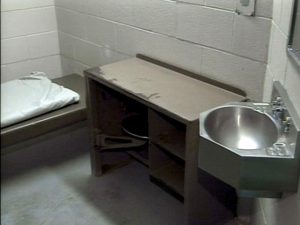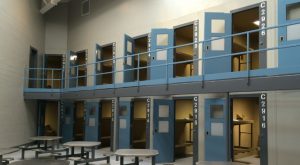LOS ANGELES
 More than 500 law enforcement officers executed a major operation Wednesday, taking into custody 32 defendants who are charged in two federal racketeering charges linked to the Mexican Mafia, officials announced.
More than 500 law enforcement officers executed a major operation Wednesday, taking into custody 32 defendants who are charged in two federal racketeering charges linked to the Mexican Mafia, officials announced.
The indictment alleges that Mexican Mafia controlled drugs and the extortion of prisoners inside the Los Angeles County jail, according to officials.
The defendants are among 83 defendants who were charged by a federal grand jury in the two indictments unsealed today.
A total of 35 defendants are already in custody in state prison or county jail facilities and are expected to be brought to federal court in the near future.
Authorities continue to search for 16 fugitives.
According to the indictment, a criminal enterprise led by members of the Mexican Mafia allegedly engaged in five broad areas of criminal activities:
- The Mexican Mafia-sanctioned smuggling of drugs into LACJ, narcotics that were sold to inmates to generate profits for the enterprise.
- The “taxing” of other drugs smuggled into LACJ in what the indictment labels “widespread extortion”
- Another jail extortion scheme in which all Latino inmates were required to contribute a percentage of their commissary spending on food and hygiene items into a “kitty” that generated additional income for the Mexican Mafia member when the kitty was sold to an inmate
- The disciplining and extortion – through assaults and fines – of Mexican Mafia associates who ran afoul of the rules imposed by the organization
- Money laundering of the criminal proceeds from these activities.
 “These cases have delivered a major blow to the Mexican Mafia and leaders of many of the street gangs under the control of the organization,” said United States Attorney Nick Hanna. “By taking out the gang members who control the jails, and by disrupting their communications network, we undermined the Mexican Mafia’s ability to coordinate street gang activity.”
“These cases have delivered a major blow to the Mexican Mafia and leaders of many of the street gangs under the control of the organization,” said United States Attorney Nick Hanna. “By taking out the gang members who control the jails, and by disrupting their communications network, we undermined the Mexican Mafia’s ability to coordinate street gang activity.”
Today’s takedown is the result of an investigation done under the auspices of the FBI’s San Gabriel Valley Safe Streets Task Force, which is made up of agents and officers with the Federal Bureau of Investigation, the Los Angeles County Sheriff’s Department, the Pomona Police Department, the Drug Enforcement Administration and the California Department of Corrections and Rehabilitation (CDCR).
 “Gang violence in the jails also spills over to the streets and adversely affects our communities,” said Paul Delacourt, the Assistant Director in Charge of the FBI’s Los Angeles Field Office. “This three-year investigation focused on players at all levels for their role in the conspiracy – from the shot-caller, to the secretary, to the dealer, to the smuggler. Today’s successful operation is a direct result of law enforcement partners working cooperatively at all levels of government.”
“Gang violence in the jails also spills over to the streets and adversely affects our communities,” said Paul Delacourt, the Assistant Director in Charge of the FBI’s Los Angeles Field Office. “This three-year investigation focused on players at all levels for their role in the conspiracy – from the shot-caller, to the secretary, to the dealer, to the smuggler. Today’s successful operation is a direct result of law enforcement partners working cooperatively at all levels of government.”
The jails indictment focuses on a period when Mexican Mafia member Jose Landa-Rodriguez and two now-deceased members of the prison gang allegedly controlled the criminal enterprise in the county jail.
The indictment explains how Landa-Rodriguez, who was incarcerated in the county jail at the time, and other leaders of the enterprise exercised power with the help of trusted “shot-callers,” facilitators and associates.
“These Mexican Mafia members and associates, working together to control criminal activity within LACJ, have become their own entity or enterprise and effectively function as an illegal government within LACJ custody facilities,” the indictment states.
 Landa-Rodriquez, 55, orchestrated a host of criminal activities, according to the indictment, which alleges that he sanctioned murders, a series of assaults, and the kidnapping and planned murder of the relative of a gang member who had defied him.
Landa-Rodriquez, 55, orchestrated a host of criminal activities, according to the indictment, which alleges that he sanctioned murders, a series of assaults, and the kidnapping and planned murder of the relative of a gang member who had defied him.
A second Mexican Mafia member, Luis Vega, 33, is named as the number 2 defendant in the LACJ indictment. Vega allegedly ordered a murder and directed assaults against those who showed disrespect or failed to follow Mexican Mafia rules.
“Operation Dirty Thirds lifts the veil on only one aspect of the complicated factors behind inmate-on-inmate assaults and the dangers to our custody staff,” said Sheriff Jim McDonnell. “Many assaults have been directed, and carried out, by the Mexican Mafia and are documented in this investigation that took more than four years.”
One of the key facilitators for Landa-Rodriguez allegedly was attorney Gabriel Zendejas-Chavez, who was arrested Wednesday.
The indictment, which notes that attorneys are particularly valued members of the operation because attorney-client privilege can serve as a shield to conceal criminal activity from law enforcement, accuses Zendejas-Chavez of conveying messages and orders related to the criminal enterprise.
 According to the indictment, Zendejas-Chavez travelled to state and federal prisons to convey messages to Mexican Mafia members, including those incarcerated at ADX Florence; conveyed information, including the names of people potentially cooperating with law enforcement, to members of the Los Angeles County Jail racketeering enterprise; and facilitated a plot to extort $100,000 from the Mongols outlaw motorcycle gang.
According to the indictment, Zendejas-Chavez travelled to state and federal prisons to convey messages to Mexican Mafia members, including those incarcerated at ADX Florence; conveyed information, including the names of people potentially cooperating with law enforcement, to members of the Los Angeles County Jail racketeering enterprise; and facilitated a plot to extort $100,000 from the Mongols outlaw motorcycle gang.
Inside the jails, drug trafficking generated revenues for leaders of the criminal enterprise in two ways, according to the indictment.
Once narcotics were smuggled into jail facilities at the direction of the Mexican Mafia members and their shot-callers, the narcotics were sold to inmates – and those who possessed other narcotics were not allowed to sell their drugs until the Mexican Mafia member’s drugs were sold.
Second, the Mexican Mafia collected a “thirds” tax on all other drugs smuggled into the county jail. This meant that one-third of all narcotics smuggled into the county jail had to be “broken-off” and given to the Mexican Mafia member or his shot-caller in control of the facility.
If the Mexican Mafia member decided to sell the “thirds-tax” portion of the drugs, others in the facility were prohibited from selling drugs until the Mexican Mafia member had sold his “thirds.”
This rule led to the name of the investigation: Operation “Dirty Thirds.”
“The Mexican Mafia prison gang is a key component of the illicit drug supply chain, largely controlling narcotics distribution perpetrated by violent street gangs,” said DEA Special Agent in Charge David J. Downing. “Extinguishing La eMe’s ability to facilitate organized rackets, drug crimes, and associated violence is a top priority for DEA, and we’re embedded with countless law enforcement partners in this ongoing effort.”
“CDCR and the Office of Correctional Safety would like to thank our partners in the San Gabriel Valley Safe Streets Gang Task Force,” said John Prelip, CDCR Special Service Unit Special Agent-In-Charge. “We know the Mexican Mafia operates within state prisons to conduct criminal activities on the outside through very sophisticated networks. Our hope is that investigations such as these send a message to these gangs that law enforcement – both inside and outside prisons or jails – will continue to work together to dismantle their operations, and protect the community.”
The second RICO indictment unsealed today focuses on a second criminal enterprise that allegedly was run by another incarcerated member of the Mexican Mafia, Michael Lerma, 61, also known as “Pomona Mike.”
Lerma exercised control over and extorted drug proceeds from, Latino street gangs in and around Pomona, as well as from incarcerated Latinos in Calipatria State Prison in Imperial County.
Members of Lerma’s criminal enterprise also allegedly engaged in robberies, identity theft and fraud, drug trafficking, kidnapping, and other acts of violence.
Lerma profited from these criminal activities when top-level female associates are known as “señoras” deposited proceeds into his prison account, according to the indictment.
In one incident alleged in the indictment, members of Lerna’s criminal enterprise attempted to steal a Mercedes-Benz automobile that was owned by a county jail inmate.
When the caretaker of the car refused to turn over the vehicle, one of the defendants named in the indictment shot him.
In another incident allegedly involving members of Lerma’s organization, a woman was kidnapped, held for several days while being extorted for money, and was going to before murdered before the plot was disrupted by law enforcement.
“The Pomona community certainly suffered from the criminal acts of those indicted,” said Pomona Police Chief Michael Olivieri. “I am very pleased with the success of this long-term investigation, and I am looking forward to more collaboration with our law enforcement partners in future investigations.”
The two indictments unsealed today charge a host criminal offenses, including conspiracy to engage in racketeering activity; violent crimes in aid of racketeering activity; carjacking; conspiracy to distribute and possess with intent to distribute methamphetamine, heroin, cocaine, and marijuana; distribution of and possession with intent to distribute controlled substances; money laundering; possession of at least 15 access devices (credit card numbers); aggravated identity theft; and use, possession or discharge of a firearm in furtherance of a crime of violence or drug trafficking crime.
If convicted, most of the defendants could be sentenced to decades in federal prison, and some could face life without parole.
Defendants are presumed innocent unless found guilty.

